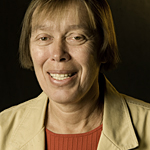
Tatiana Timofeeva
Las Vegas, NM — New Mexico Highlands chemistry professor Tatiana Timofeeva was named professor of the year for 2013 — 2014 at the 16th Annual Student Leadership Recognition Banquet April 9.
Several chemistry students and professors nominated Timofeeva for the honor. The Office of Campus Life coordinates the recognition event, and a committee of faculty, staff and students selected Timofeeva from other nominees.
“To me, the most important achievement of Dr. Timofeeva is training students to be excellent in research,” wrote chemistry graduate student Luis Raíºl Castañeda.
Graduate chemistry student Evgheni Jucov wrote: “If students have questions regarding their courses or research topics, Dr. Timofeeva always finds time to help them, sharing her vast knowledge base and enormous experience.”
All the students noted in their letters that Timofeeva is an accomplished researcher.
Indeed, she has published more than 240 research studies, many as first author. Timofeeva is an internationally known chemist who studies the forms and structures of crystals. Her research colleagues range from UC Berkeley, Georgia Tech, and Highlands to Los Alamos National Laboratory.
The Moscow-born Timofeeva earned her Ph.D. in physical chemistry at the Russian Academy of Sciences in her hometown. Her primary research interest lies in structural, experimental and theoretical studies of organic nonlinear optics — how materials change as light passes through them.
Timofeeva’s studies have been published in scholarly journals in the United States like the Journal of the American Chemical Society and internationaljournals like Angewandete Chemie.
“It’s important to document your research in peer-reviewed publications and my research experience helps me be a better teacher,” Timofeeva said. “I’m glad I’m teaching my students to publish their own research as first authors, and present at national and international conferences.”
Over the years, more than 10 of Timofeeva’s students from Highlands have gone on to doctoral studies, with many more working in her lab.
“My students’ success is the most rewarding part of being a professor. I try to keep in touch with my students and enjoy hearing about their new jobs and when they are invited to present their research. I also like hearing when they marry and have children,” Timofeeva said.
Highlands computer science professor Gil Gallegos wrote a letter nominating Timofeeva for Professor of the Year.
“Dr. Timofeeva has made a difference in so many lives of my graduate and undergraduate students in my nine years at Highlands,” Gallegos said. “She has an undying passion for her work and it spills over into every aspect of her work at Highlands. It is her nature to help, nurture and teach all persons that work with her — both students and faculty.”
Timofeeva has been highly successful in securing scientific grant funding for Highlands to build its research capacity and fund student research.
A major highlight was in 2004, when Timofeeva was the principal investigator for a National Science Foundation grant that funded a state-of-the-art X-Ray Diffraction Laboratory.
“The X-Ray diffractometer allows us to analyze how atoms and molecules are organized inside a crystal. What’s unique about our lab is that we have a laser-driven device that helps us grow crystals from liquids — like ethanol — and convert them to solids for analysis,” Timofeeva said.
Another highlight occurred in 2009, when Timofeeva was the principal investigator for a $2.7 million NSF Partnerships for Research and Education in Materials (PREM) grant.
One research focus of the PREM grant is biophotonics, the interaction between light and matter. An example of biophotonics research is using light to kill cancer cells.
“This PREM grant has given our students the chance to conduct cutting-edge research and present their findings at prestigious conferences,” Timofeeva said.
In March, New Mexico EPSCoR, the NSF funded Experimental Program to Stimulate Competitive Research, notified Timofeeva that her seed grant proposal was funded.
“This grant allows us to purchase a differential scanning calorimetry instrument used for researching the temperature at which solid materials are stable. Chemicals need to be stable for applications like optical monitors,” Timofeeva said.
Timofeeva was a research scientist in Russia for 20 years. Then in 1996, Ron Clark, a Highlands chemistry professor at the time, invited Timofeeva and her husband, Mikhail Antipin, another renowned Russian crystallographer, to Highlands to work on NASA-supported research involving specific organic materials for photogenics and optoelectronics.
Both chemists stayed on to teach and conduct research at Highlands. Antipin died in 2013 and Timofeeva is the guest editor for an upcoming special edition of the journalCrystal Growth & Design dedicated to his memory.
